Artnet News Pro
7 Key Questions About How DAOs Could Actually Work for the Art Market, Answered
In a market as elitist, opaque, and illogical as the one for fine art, could DAOs really take hold?
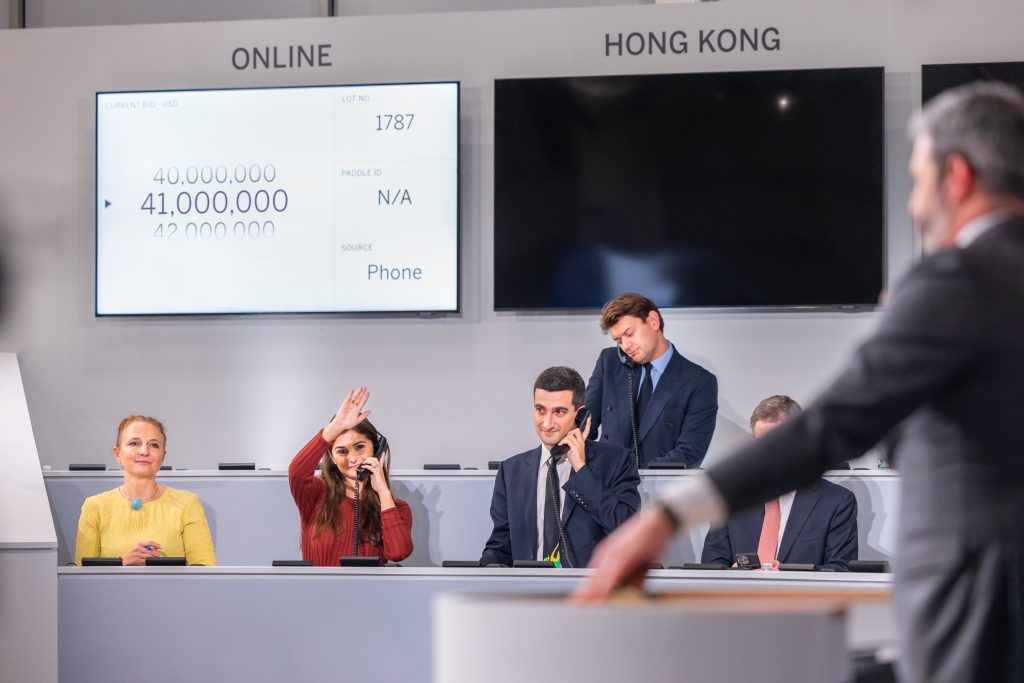
In a market as elitist, opaque, and illogical as the one for fine art, could DAOs really take hold?

Amy Castor

This article first appeared in the spring 2022 Artnet Intelligence Report. Download the full magazine here.
Imagine this: A collective of crypto enthusiasts fights bitterly for a Yayoi Kusama pumpkin sculpture at Christie’s, bidding it up to a record $8 million. They win, pay in cryptocurrency, and have the prize shipped to an art-storage facility.
In the utopian version of this story, thousands of members of this online group vote to donate the sculpture to a museum in Buffalo, New York, which puts it on view in a public park. In the dystopian version, the members decide to destroy the physical sculpture, turn it into an NFT, and sell fractionalized shares of their new digital asset. The IRL work is reduced to dust; its memory now lives exclusively online.
Both of these developments are theoretically possible in the future, as decentralized autonomous organizations , or DAOs, continue to gain popularity in the crypto space. Several of these newfangled entities are already scooping up high-profile NFTs in the name of democratizing art.
Crypto supporters claim that DAOs give regular people the chance to have unprecedented influence. Forget CEOs and central leaders. Instead, decisions are made collectively on the blockchain. But in a market as elitist, opaque, and illogical as the one for fine art, could DAOs really take hold? And will they become a force for good or ill?
We surveyed experts in both the crypto and fine-art worlds to answer some of the most pressing questions about the future of DAOs and art.
In the simplest terms, a DAO is a way to gather a bunch of people (and crypto) together to buy things or to fund a project. You can think of a DAO as a venture-capital firm—or any type of business, really—but on the blockchain. Instead of having the rules and contracts spelled out on paper, everything is written in code.
Although one of the earliest DAOs, called “The DAO,” got off to a bad start (it was hacked in 2016), it managed to pool $150 million in crypto before it shut down. And even that is small potatoes compared with the funds that started flowing into DAOs late last year, including from top venture capital firms like Andreessen Horowitz.
Today, DAOs hold about $10.7 billion in cryptocurrency assets and collectively have around 1.6 million members, according to data analytics site DeepDAO.
To become a member of a DAO, you have to purchase the DAO’s governance token. Typically, the more tokens you hold, the more voting power you have in how the pooled funds are spent.
To some observers, joining a DAO is no different from buying stock—except there is a lot less regulation. “As far as I can tell, the idea behind a DAO is to create a joint stock corporation designed around basic majority shareholder voting without doing the paperwork necessary to do a joint stock corporation,” said Nicholas Weaver, a researcher at the University of California, Berkeley.
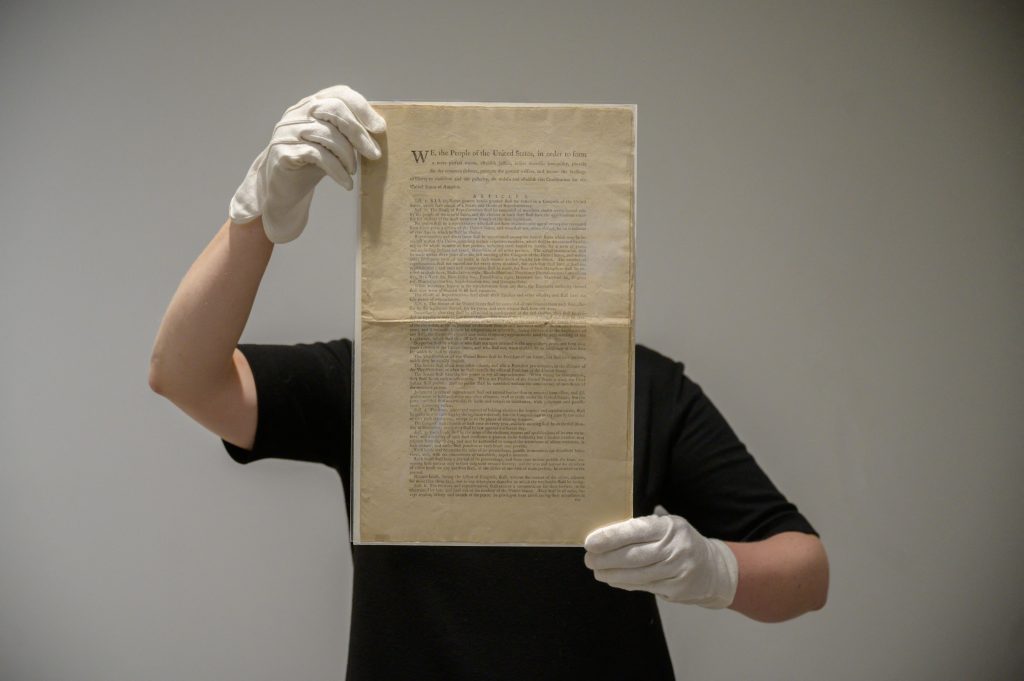
The first printing of the United States Constitution, which sparked a bidding war between a DAO and a hedge-fund titan at Sotheby’s last fall. (Photo by ED JONES/AFP via Getty Images)
After raising more than $40 million in crypto in a week, ConstitutionDAO bid on a rare copy of the U.S. Constitution at Sotheby’s in November. The group lost to the hedge-fund kingpin Ken Griffin, who—armed with the knowledge of just how much his opponents had raised—outbid the DAO by a slim margin. He ended up paying $43.2 million, more than double the estimate and a record for a historical document at auction.
That was not the only time a DAO has bid up the price of an item. At Christie’s in November, SpiceDAO won a $3 million rare storyboard book of Alejandro Jodorowsky’s never-made Dune adaptation, paying nearly 100 times its high estimate.
The group tossed around the idea of burning the book and creating NFTs of each page to sell online. (A free and accessible copy is already available digitally.) It also wanted to create a film adaptation, seemingly unaware that owning an NFT does not automatically bestow title to copyright.
Andreessen Horowitz-backed PleasrDAO, which is dedicated to buying “culturally significant pieces,” has also purchased notable items, including the sole copy of the album Once Upon a Time in Shaolin by the Wu-Tang Clan. After locking the $4 million object in a vault somewhere in New York, the collective created an NFT to represent a deed of ownership. It also paid $4 million in crypto for an NFT of the Shiba Inu meme that launched the infamous Dogecoin cryptocurrency, which it proceeded to fractionalize into 17 billion $DOG tokens to sell on secondary markets.
These structures raise concerns among regulators, even those who embrace cryptocurrencies. One pro-crypto SEC commissioner has warned that fractionalized NFTs resemble illegal securities offerings. Exactly how such assets will be treated and traded in the future remains to be seen.
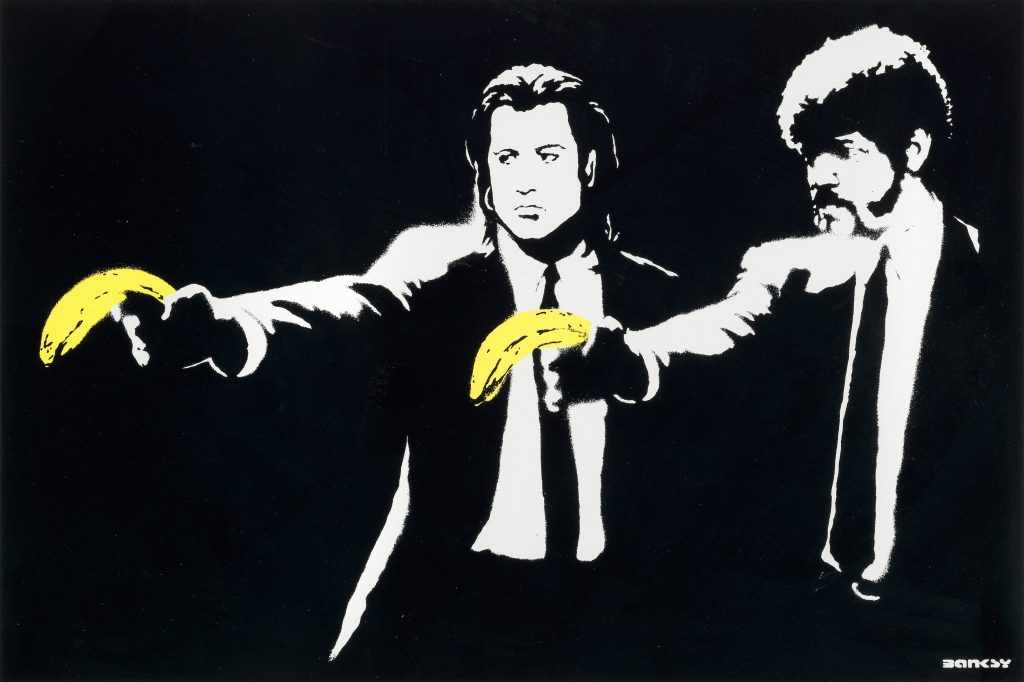
Banksy, Pulp Fiction (2004). Courtesy of the artist.
Yes. Newly formed ratDAO has a lofty goal to buy blue-chip art on a “large scale,” in the words of its founder, Shan Xu, a recent graduate of the University of Houston with a degree in economics and no background in art. So far, ratDAO has made one purchase: a Banksy print, Pulp Fiction (2004), from Hexagon Gallery for $99,500. (Technically, an LLC made the purchase on behalf of the DAO.)
“We are just a bunch of internet kids that bought a Banksy,” Xu said. RatDAO currently has 758 members. Rather than destroying physical artworks, Xu envisions showing acquisitions in a gallery in New York City that will double as a kind of members-only clubhouse. (There are also plans to create NFTs of the physical art and display them in the metaverse.) When the DAO goes live later this year, it will be represented by an appropriately named $CHEESE token.
“We are hoping to get into higher art, like a Basquiat or a Monet,” Xu said. “We’ll be the first [DAO] to own tokenized versions of these pieces.”
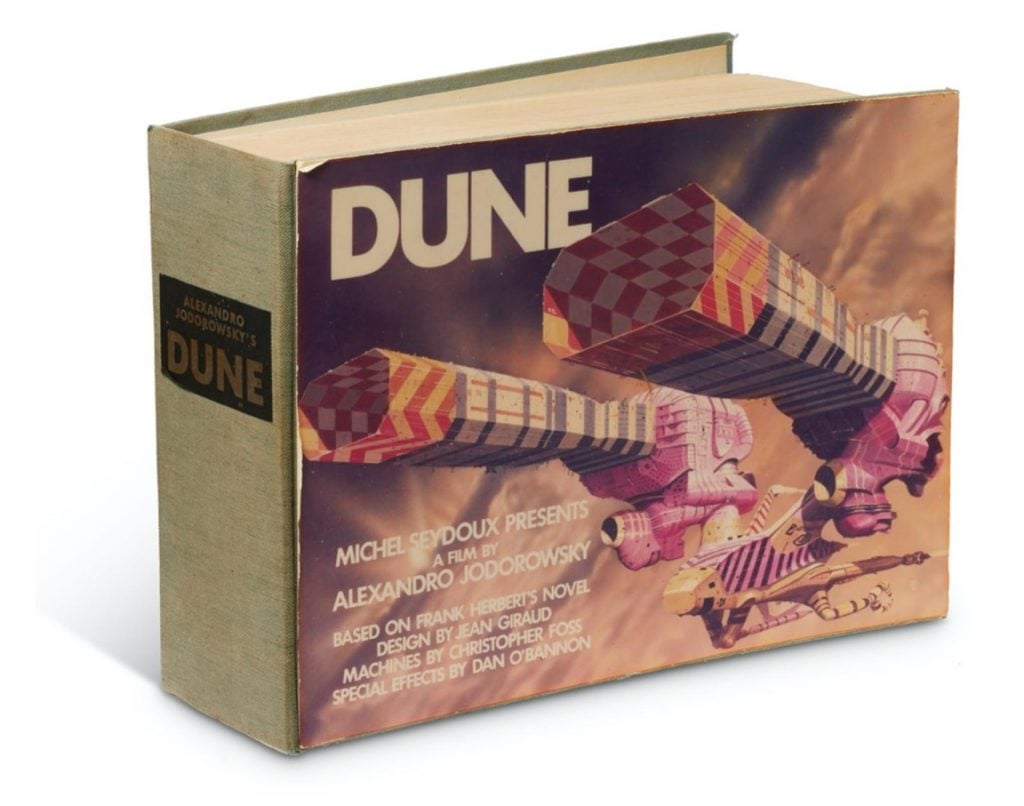
SpiceDAO picked up a storyboard of Alejandro Jodorowsky’s never-made Dune adaptation (1975) at Christie’s for $3 million Photo courtesy of Christie’s.
DAOs seem more focused on NFTs than on physical art objects. Ultimately, DAOs are about pumping up the value of the governance token and any fractionalized tokens they create from NFTs. They don’t need physical art to do that.
In fact, physical art is a hassle. You have to transport it, insure it, store it somewhere, keep it in good condition, and then figure out a way to digitize it so you can share it with the group.
At the end of the day, DAOs bring liquidity to NFT markets. With a group, you have more buying power. And the flashier the NFTs a DAO collects, the greater the interest in its governance tokens.
Essentially, DAOs strive to offer the best of the fungible and nonfungible worlds—a governance token that is easier to trade with the exclusivity of a one-of-a-kind digital asset.
When it comes to acquiring fine art, DAOs quickly run into challenges. The main one is fundamental: Who is the DAO, really? While DAOs claim greater transparency because all voting and transactions take place on the blockchain, their membership is often opaque.
That can be a problem, especially in the art industry, which has long been a target for money laundering. Art dealers cannot simply accept millions of dollars in cryptocurrency from anonymous parties. And auction houses have to conduct even stricter due diligence on prospective buyers. Before ConstitutionDAO could bid on the U.S. Constitution, it had to form an LLC in Delaware. Technically, SpiceDAO didn’t even purchase the rare Dune book from Christie’s—its cofounder Soban Saqib, a 25-year-old NFT collector, did so from his home in Colorado. The DAO later bought it from him.
“As the seller, I would be worried about anti-money-laundering rules and OFAC,” said attorney Anne-Laure Alléhaut, of the firm Patterson Belknap Webb & Tyler, referring to the U.S. Treasury Department’s Office of Foreign Assets Control, which maintains a list of sanctioned countries and blocked persons. “You want to bring in new bidders, but they come with risks. DAOs could be treated like LLCs in certain jurisdictions, but what really matters is where the funds are coming from.”
Beyond that, she explained, intermediaries have a fiduciary responsibility to the sellers and might not want to risk transacting with a DAO. “Is allowing a DAO to bid on a piece of art in the best interest of the seller, considering the legal uncertainties?”
What’s more, the future of DAO regulation remains unclear. After the first-ever DAO was hacked in 2016 and had to shut down, the SEC followed up with an investigative report describing its tokens as securities.
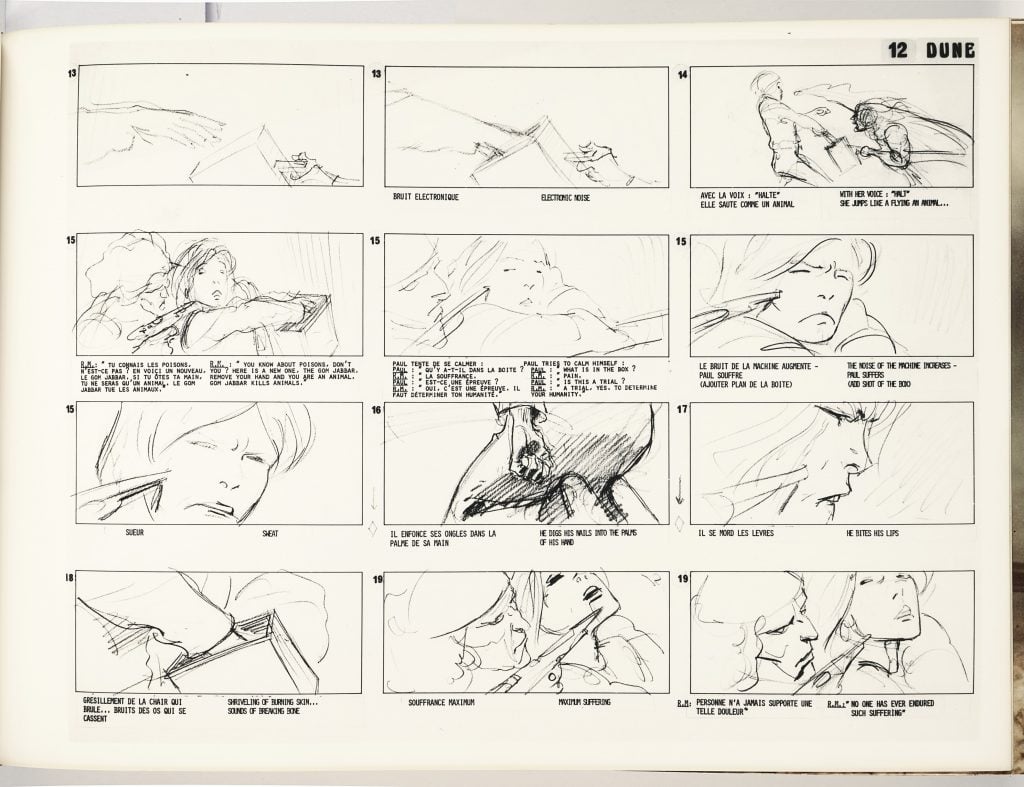
Storyboard plates from Dune, after drawings by Christopher Foss, Jean Giraud-Moebius, and H.R. Giger (1975). Courtesy of Christie’s.
Galleries and museums are still a bit leery of DAOs. The majority of the near-dozen institutions contacted for this story declined to comment. Pace—the only mega-gallery with its own NFT platform and one of the few that accepts crypto—is, perhaps unsurprisingly, at the vanguard.
“We admire their influence and, most importantly, what they stand for,” said Christiana Ine Kimba Boyle, Pace’s online sales director, adding that the gallery has been in discussions with a few DAOs. “The concept of fractionality is not new within the art world. Collectors have banded together to buy artworks for decades—especially those with high value.”
Her view isn’t shared by everyone. Ben Lee Ritchie Handler, global director of Los Angeles’s Nicodim Gallery, is put off by DAOs’ focus on profit and concerned about what might happen to a piece after it is sold.
“As a gallery, our primary goal is to put our artists’ creative output in the best possible context, be it in an institution, a public collection, or a collector’s home,” he said. “We want to draw eyeballs and opinions based on artistic merit, not a price tag.”
Handler was horrified to learn that SpiceDAO was considering destroying the rare Dune book.
A generous reader could compare such an act to Robert Rauschenberg’s famous erasure of a drawing by the Abstract Expressionist Willem de Kooning in 1953. But to Handler, SpiceDAO’s plan felt less like an artistic endeavor than “a public beheading in service of capitalism.”
This article first appeared in the spring 2022 Artnet Intelligence Report. For more on the wild world of fractional art ownership, a detailed breakdown of the leading companies in that space, and our data-led analysis of last year’s auction results, download the full issue here.